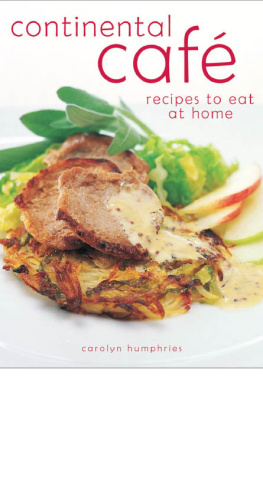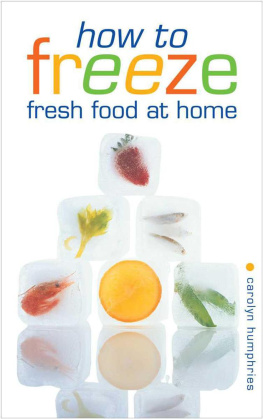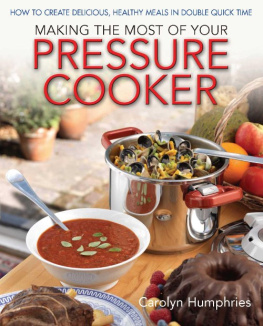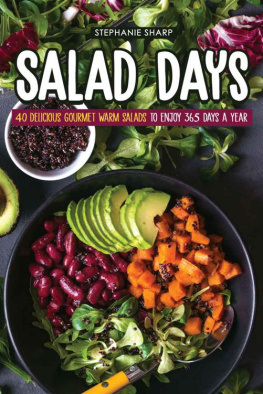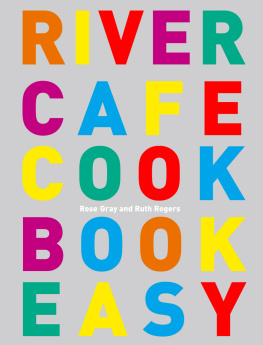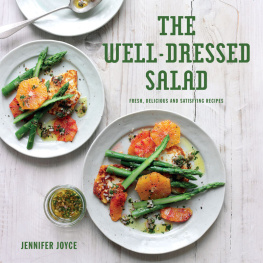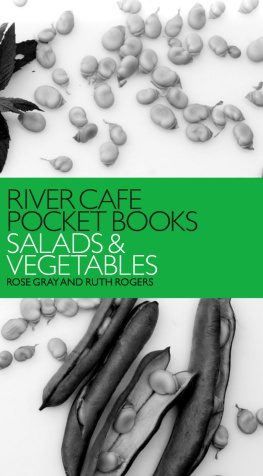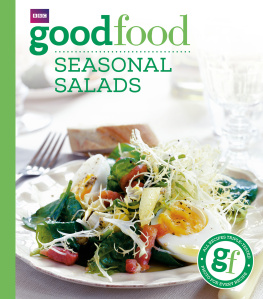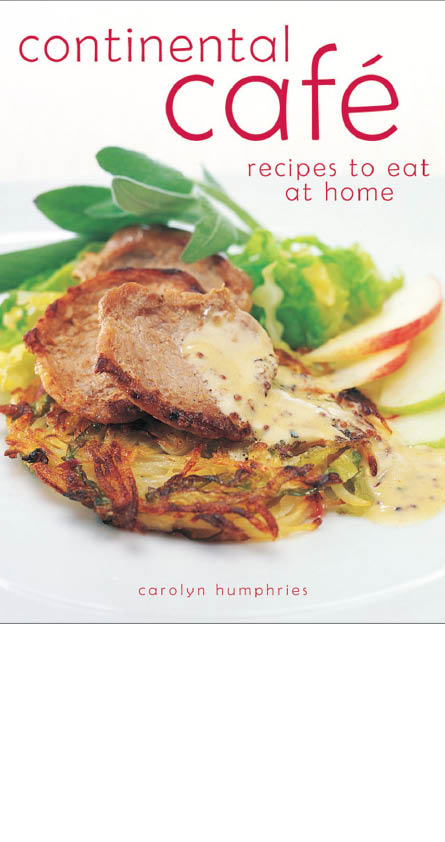Copyright 2004 and 2012 W. Foulsham & Co. Ltd
The Copyright Act prohibits (subject to certain very limited exceptions) the making of copies of any copyright work or of a substantial part of such a work, including the making of copies by photocopying or similar process. Written permission to make a copy or copies must therefore normally be obtained from the publisher in advance. It is advisable also to consult the publisher if in any doubt as to the legality of any copyright which is to be undertaken.
W. Foulsham & Co. Ltd
Introduction
Continental Caf uses only the freshest ingredients in new and imaginative combinations, menus feature such mouth-watering dishes as Crispy castello on rocket with fresh cranberry dressing, Tuna steaks with a herb and anchovy vierge and baby chargrilled peppers, Warm duck breast salad with courgettes and fresh raspberries, or Mango and passion fruit crme brule. But these are not selections from a riverside caf menu! They are just some of the dishes from this fascinating new book, so everyone can enjoy the caf style at home.
Caf-style Entertaining
When you are entertaining, you want everything, from selecting your menu to presenting the food and pouring the wine, to go off perfectly. Just a little thought and planning will make all the difference to the success of the occasion.
Setting the scene
Caf-style entertaining should be high on style and low on stress. Aim to achieve a low-key, relaxed atmosphere.
Soft lighting is essential. Choose table or standard lamps or wall lights rather than a bright central overhead light (unless you have a dimmer switch). But dont have it so dark that your guests cant appreciate the beautiful creations you are serving them! Supplement the lamps with a candle on the table, especially if its a romantic occasion.
Choose some smooth, downbeat music. You are looking for something that will contribute to the atmosphere but not distract from the conversation or the food, so keep the volume down its not called background music for nothing. Soft music will not only keep you relaxed while you prepare the meal, it will also help to break the ice while you and your guests chat and enjoy your pre-dinner drinks, and wait for everyone to arrive before you sit down to eat.
The design of your table setting is important in setting the scene for the meal. You should try to create an informal look, but do avoid a red checked cloth and a candle in a Chianti bottle theyre decidedly pass! That said, simplicity is important, so this is not an occasion for the candelabra and the polished silverware. Instead, if youve got a decent wooden table, all you need to do is put out your place mats, or perhaps a plain coloured cloth. Opt for a single candle and just one flower, or a plain arrangement, rather than a big centrepiece.
Choose plain white crockery if possible. If you dont have white, any plain colour will be effective; busy patterns detract from both the atmosphere and the food. Really large plates are best: when you are serving a caf-style meal, large plates allow you to go to town with your presentation and to make the food look more attractive. They also provide more space around the food, so that you can add a drizzle of sauce or a dusting of icing sugar without it smothering the food or crowding the ingredients together. The effect youre looking for is a bit like minimalist room design white space, clear surfaces, attractive but uncluttered decoration, with clever touches of colour here and there to add contrast.
Linen napkins are best when you are entertaining guests. If you prefer to use disposable napkins, buy large linen-effect paper ones. Either fold them neatly and place them in the glasses or put them on side plates, whichever you prefer. Forget those water-lilies and bishops hats that we used to put on the place mats they went out with the candles stuck in the wine bottles.
On a practical note, make sure each guest has enough cutlery for every course arrange it on either side of the plate (not above the place mat), starting with the first course and working from the outside in. Set out glasses for wine and water, and dont forget the serving spoons and salad servers if you need them.
Choosing your menu
In general, the easiest route to is to select your main course first, then choose some suitable accompaniments (Ive done this bit for you!), and finally decide which starter and dessert will make the perfect meal. The key word to remember is variety. You need to consider several different elements, and these apply whether you are eating in a restaurant or choosing dishes to serve at home.
First, you should avoid any repetition of ingredients. For instance, you shouldnt serve a fish soup followed by a fish main course, or a fruit starter followed by a meat and fruit main course and a fruity pudding.
Youll also need to consider the cooking methods. For example, a fried cheese and cranberry starter, followed by deep-fried plaice and oysters, with pancakes for dessert would probably be too much for even the most ardent lover of fried food.
Vary the temperature of the food too, for your own sake as much as your guests. Dont go for all hot dishes (too much to keep warm) or all cold (not enough variety). If you choose a hot starter and hot main course, always go for a cold dessert. The most practical choice from the cooks point of view is to serve a cold starter and dessert, as they can be made in advance with just a few last-minute finishing touches, perhaps with a hot main course.
Try to introduce lots of different colours and textures. The combination of fried foods I mentioned above would be predominantly brown not a good choice unless you want your meal to look dull and unappetising and there would be rather too much crunch in the texture. The combinations and presentations of everything in this book have been carefully selected to help you produce dishes that look and taste interesting and exciting!
Choosing the drinks
You will almost certainly be serving aperitifs before the meal. Once again, the best advice here is to keep it simple. If theres too much choice, your guests will take longer to make their decision and settle down to relax and its more trouble for you, as well. I like to serve a choice of one or two cocktails, and Ive included lots of ideas for these in the drinks chapter. Another option is to offer a glass of sparkling wine either plain or with orange juice (Bucks Fizz) or blackcurrant liqueur (Kir Royale). Alternatively, you can simply offer red or white wine or beer.
Always provide sparkling or still water and other soft drinks, such as pure fruit juices or carbonated drinks, even if you know that no one is driving.
Dont offer huge bowls of nibbles with your pre-dinner drinks theyll only fill people up. At most, a dish of olives and perhaps some baby gherkins, nuts or some interesting flavoured crisps are sufficient.
When it comes to providing drinks to accompany the meal itself, most people like a choice of red or white wine, and you should always offer water to your guests as well. Strictly speaking, to be true to the style of this book I suppose you should choose French or Italian wines, but I think thats going too far: if you have a favourite, who cares if its Australian!

